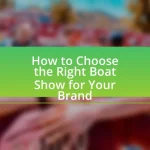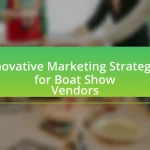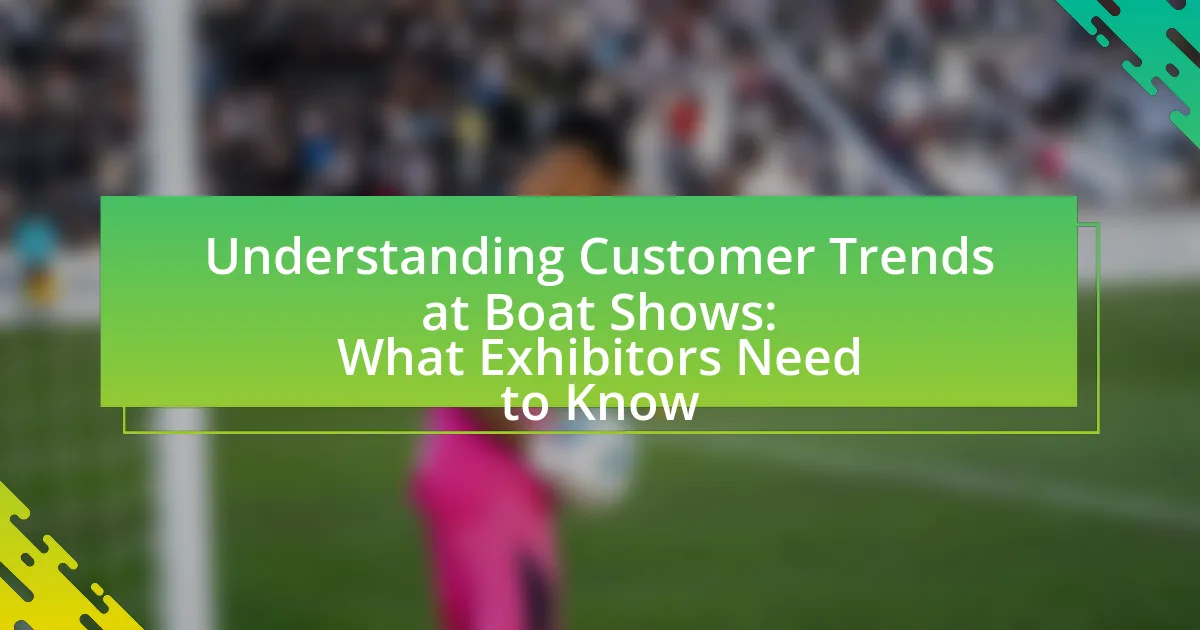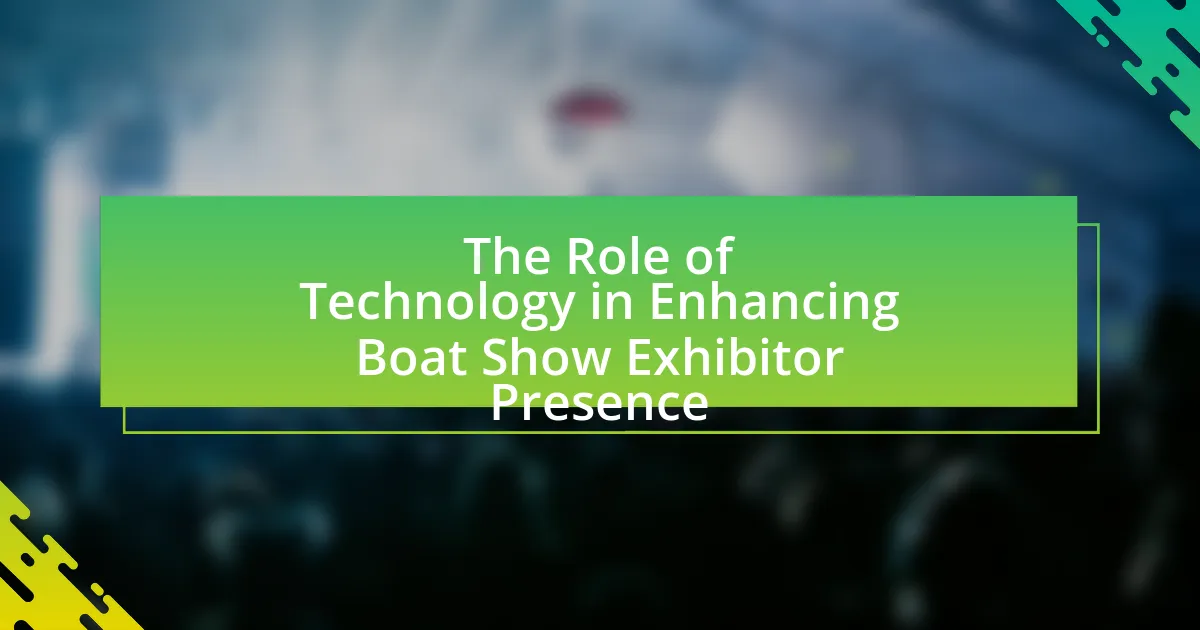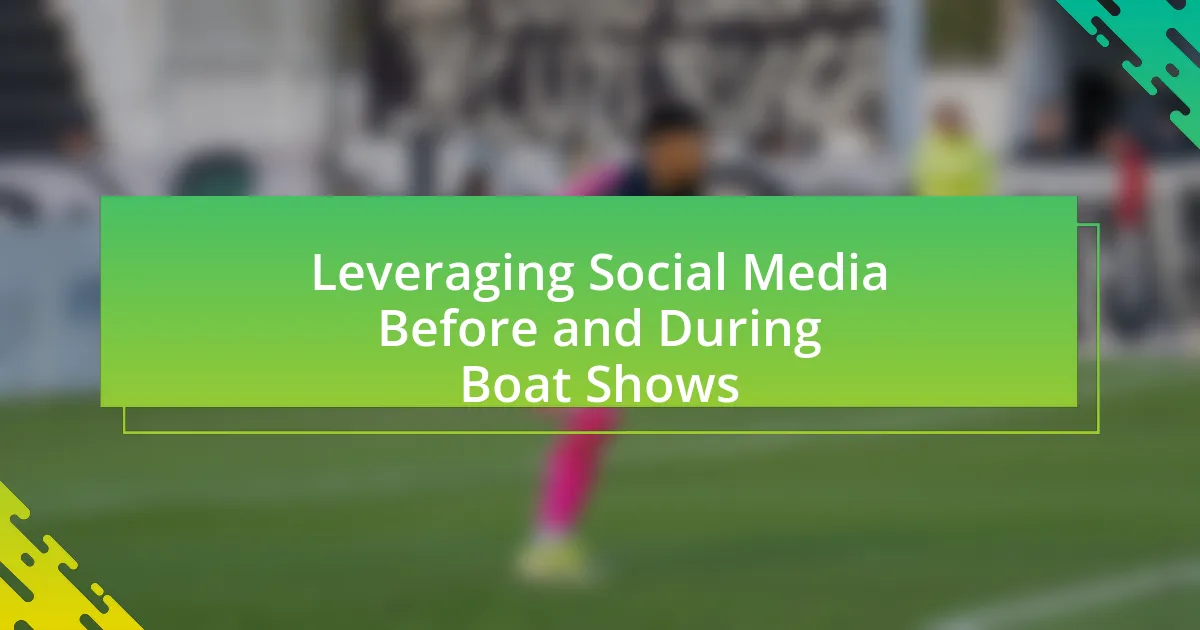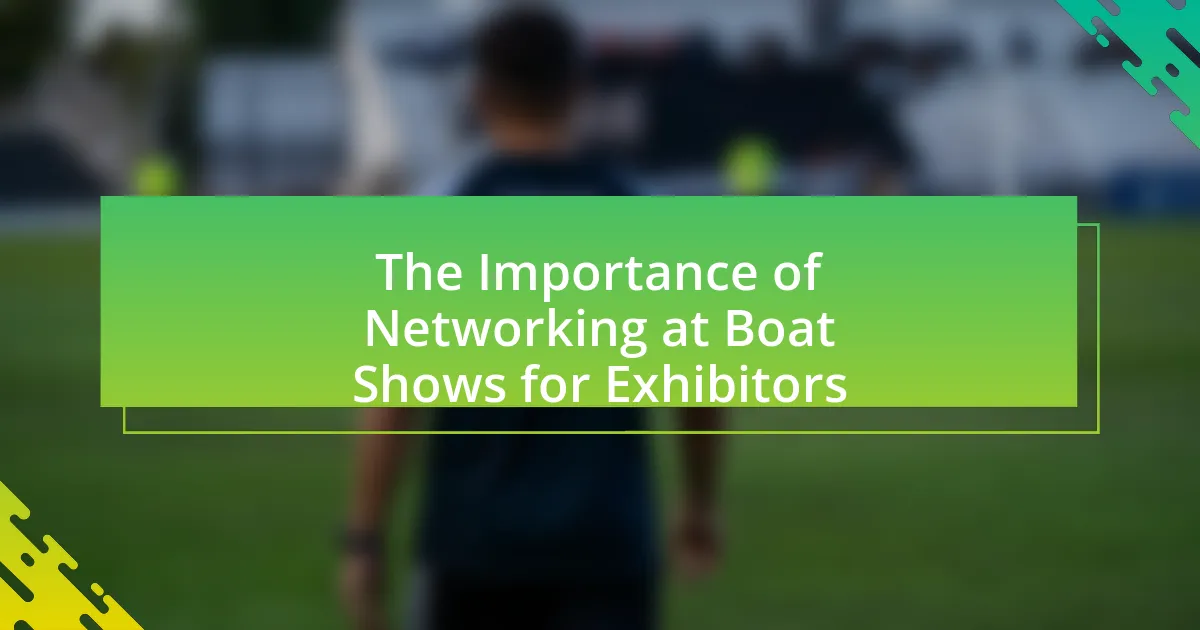The article focuses on maximizing booth space for exhibitors at boat shows, emphasizing key strategies such as effective layout, engaging displays, and optimized marketing materials. It outlines the importance of visibility and interaction through strategic booth design, product placement, and the use of technology to enhance visitor engagement. Additionally, the article discusses logistical considerations, staffing best practices, and follow-up strategies to ensure successful lead generation and conversion post-event. By implementing these strategies, exhibitors can create an inviting environment that attracts visitors and drives sales.
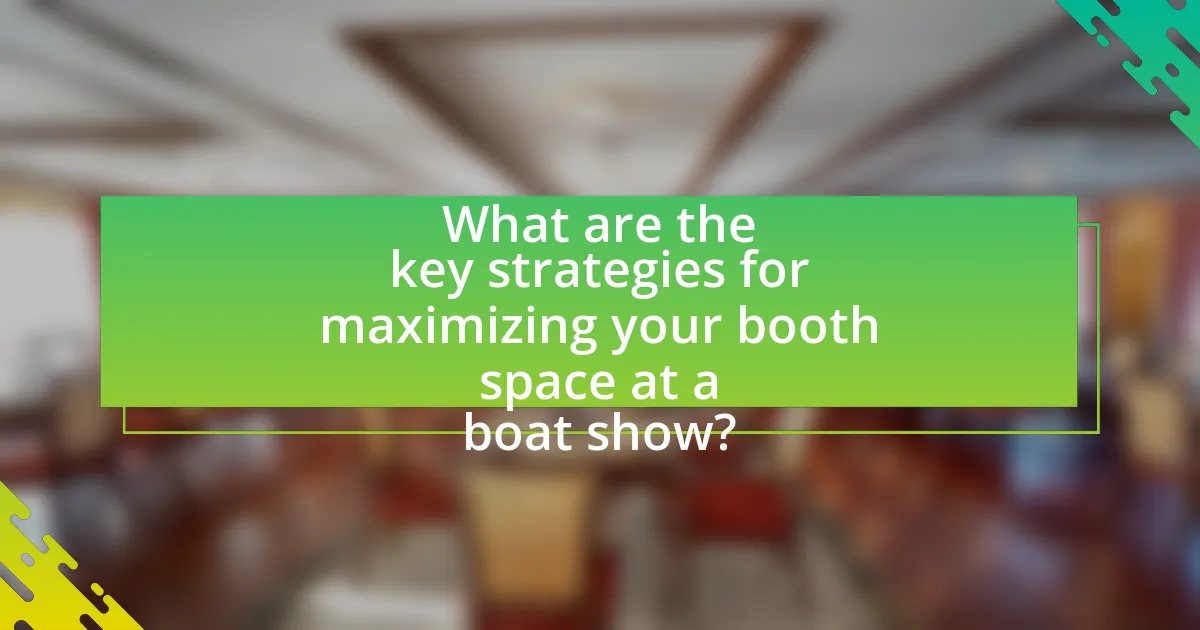
What are the key strategies for maximizing your booth space at a boat show?
To maximize booth space at a boat show, exhibitors should focus on strategic layout, engaging displays, and effective marketing materials. A well-planned layout allows for easy navigation and visibility, ensuring that visitors can easily access products and information. Engaging displays, such as interactive elements or live demonstrations, attract attention and encourage visitor interaction, which can lead to increased interest and sales. Additionally, using clear and concise marketing materials, including brochures and signage, helps communicate key messages quickly, enhancing the overall effectiveness of the booth. These strategies are supported by industry best practices, which emphasize the importance of creating an inviting and informative environment to capture visitor interest and drive engagement.
How can effective booth design enhance visibility and engagement?
Effective booth design enhances visibility and engagement by utilizing strategic layout, eye-catching graphics, and interactive elements. A well-organized space allows for clear sightlines and easy navigation, which attracts attendees and encourages exploration. Research indicates that booths with high-quality visuals can increase foot traffic by up to 30%, as compelling designs draw attention and create a memorable impression. Additionally, incorporating interactive features, such as touchscreens or product demonstrations, fosters deeper engagement, allowing visitors to connect with the brand on a personal level. This combination of visibility and interaction ultimately leads to higher conversion rates and a more successful exhibition experience.
What layout options are most effective for attracting visitors?
Open layouts with clear sightlines and interactive elements are the most effective for attracting visitors. These layouts allow for easy navigation and visibility, encouraging foot traffic. Research indicates that booths with open designs can increase visitor engagement by up to 30%, as they create an inviting atmosphere that draws people in. Additionally, incorporating interactive displays or demonstrations can further enhance visitor interest, as studies show that hands-on experiences significantly boost attendee interaction and retention.
How can signage and branding be optimized for maximum impact?
Signage and branding can be optimized for maximum impact by ensuring clarity, visibility, and relevance to the target audience. Clear messaging allows potential customers to quickly understand the brand’s value proposition, while high-contrast colors and large fonts enhance visibility from a distance. Research indicates that 70% of consumers form an opinion about a brand based on its signage alone, highlighting the importance of effective design. Additionally, incorporating elements that resonate with the boating community, such as imagery of boats or water, can create a stronger emotional connection, further enhancing brand recall and engagement.
What role does product placement play in booth effectiveness?
Product placement significantly enhances booth effectiveness by strategically positioning products to attract attention and engage potential customers. Effective product placement increases visibility and creates a focal point that draws attendees into the booth, thereby improving interaction rates. Research indicates that well-placed products can lead to a 30% increase in visitor engagement, as they create a more immersive experience that encourages exploration and conversation. This strategic positioning not only showcases the products but also reinforces brand identity, making it easier for attendees to remember the brand after the event.
How should products be arranged to encourage interaction?
Products should be arranged in a way that promotes accessibility and visibility to encourage interaction. Placing high-demand items at eye level and within easy reach increases the likelihood of engagement, as studies show that products positioned prominently attract more attention. Additionally, creating open pathways allows visitors to navigate freely, fostering a welcoming environment that invites exploration. Research indicates that interactive displays, such as product demonstrations or hands-on experiences, significantly enhance visitor interaction, making it essential to incorporate these elements into the arrangement strategy.
What are the best practices for showcasing large items like boats?
The best practices for showcasing large items like boats include utilizing strategic positioning, creating an inviting layout, and incorporating effective visual elements. Positioning the boat at an angle allows for better visibility and access, while ensuring ample space around it facilitates visitor movement. An inviting layout can be achieved through the use of complementary displays, seating areas, and clear signage that guides attendees. Effective visual elements, such as high-quality graphics and lighting, enhance the boat’s features and attract attention. These practices are supported by industry standards that emphasize the importance of accessibility and aesthetics in maximizing engagement at boat shows.
How can technology be utilized to enhance booth experience?
Technology can enhance booth experience by integrating interactive displays, virtual reality, and mobile applications. Interactive displays engage visitors by allowing them to explore products or services through touchscreens, which can increase retention of information. Virtual reality can provide immersive experiences, enabling potential customers to visualize products in a realistic setting, thereby enhancing their understanding and interest. Mobile applications can facilitate easy access to information, schedule appointments, and collect visitor data, streamlining communication and follow-up processes. According to a study by the Event Marketing Institute, 74% of attendees are more likely to engage with a brand that uses technology in their booth, demonstrating the effectiveness of these technological enhancements in attracting and retaining visitor attention.
What types of interactive displays can engage attendees?
Interactive displays that can engage attendees include touchscreens, virtual reality experiences, augmented reality applications, and gamified elements. Touchscreens allow users to navigate content and interact with products directly, enhancing engagement through hands-on experiences. Virtual reality immerses attendees in a simulated environment, making them feel part of the experience, while augmented reality overlays digital information onto the real world, providing interactive learning opportunities. Gamified elements, such as quizzes or competitions, encourage participation and can create a fun atmosphere, increasing foot traffic and interest in the booth. These types of displays have been shown to significantly enhance attendee interaction and retention of information, making them effective tools for exhibitors.
How can digital tools improve lead generation at the booth?
Digital tools can significantly enhance lead generation at the booth by streamlining data collection and improving engagement with potential customers. For instance, using tablets or smartphones equipped with lead capture software allows exhibitors to quickly gather contact information and qualify leads on-site, reducing the reliance on paper forms. Research indicates that companies utilizing digital lead capture methods can increase their lead conversion rates by up to 30%. Additionally, interactive displays and virtual reality experiences can attract more visitors, creating memorable interactions that foster interest and encourage follow-up. These tools not only facilitate immediate engagement but also enable exhibitors to analyze data post-event, refining their strategies for future shows.
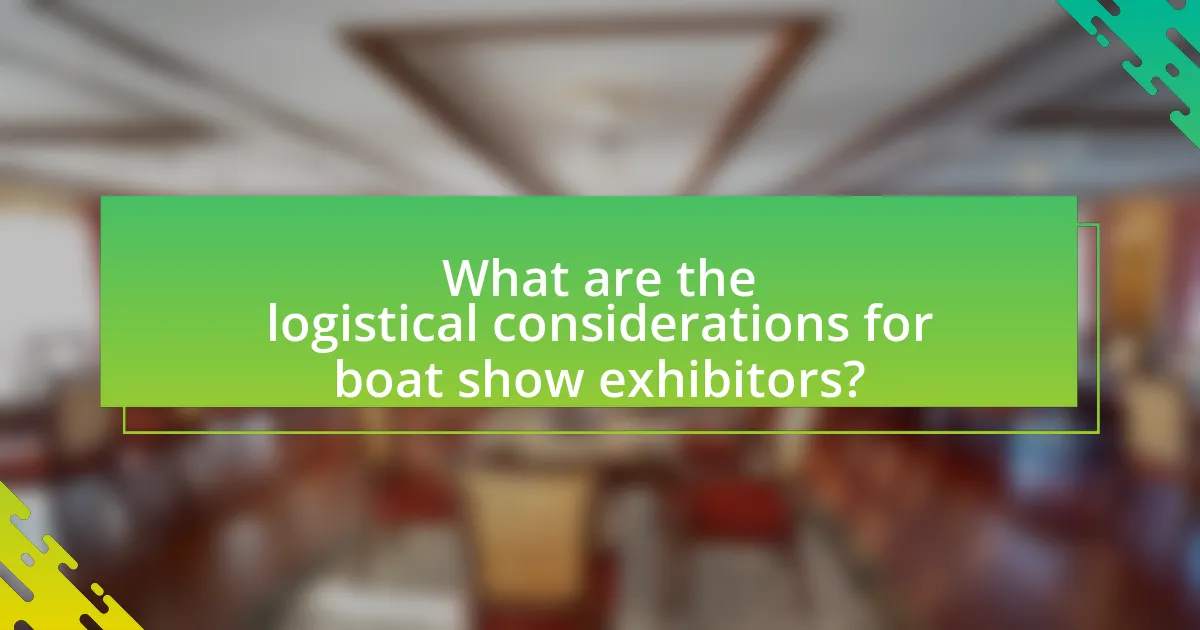
What are the logistical considerations for boat show exhibitors?
Boat show exhibitors must consider several logistical factors, including booth design, transportation of exhibits, and compliance with show regulations. Effective booth design should maximize visibility and accessibility, ensuring that products are displayed attractively and can be easily accessed by attendees. Transportation logistics involve planning for the safe and timely delivery of boats and materials to the venue, which may require coordination with shipping companies and adherence to specific timelines. Compliance with show regulations is crucial, as exhibitors must follow guidelines regarding booth size, setup procedures, and safety standards to avoid penalties or removal from the event. These considerations are essential for a successful exhibition experience.
How can exhibitors effectively manage booth setup and teardown?
Exhibitors can effectively manage booth setup and teardown by creating a detailed plan that outlines each step of the process, including timelines and responsibilities. This structured approach ensures that all team members understand their roles and the sequence of tasks, which minimizes confusion and delays. For instance, a study by the Event Marketing Institute found that 70% of exhibitors who utilized a checklist for setup reported a smoother process, highlighting the importance of organization. Additionally, scheduling teardown to begin immediately after the event ends allows for a more efficient exit, as it reduces the risk of last-minute rushes and potential damage to materials.
What are the timelines for setup and breakdown at boat shows?
Setup at boat shows typically occurs one to three days before the event opens, allowing exhibitors to arrange their booths and display their products. Breakdown usually takes place immediately after the show concludes, often within one to two days, depending on the size of the event and the specific regulations of the venue. For example, larger boat shows may require more time for both setup and breakdown due to the complexity and volume of exhibits.
How can exhibitors ensure compliance with venue regulations?
Exhibitors can ensure compliance with venue regulations by thoroughly reviewing the venue’s guidelines and requirements prior to the event. This includes understanding restrictions on booth dimensions, electrical usage, and safety protocols. Additionally, exhibitors should communicate with venue management to clarify any uncertainties and obtain necessary permits. Compliance can be further ensured by conducting a pre-event checklist that includes verifying that all materials and equipment meet the specified regulations. According to the International Association of Exhibitions and Events, adherence to venue regulations is crucial for maintaining safety and avoiding penalties, which reinforces the importance of proactive compliance measures.
What are the best practices for staffing the booth?
The best practices for staffing a booth include ensuring adequate coverage, training staff on product knowledge, and engaging with attendees effectively. Adequate coverage means having enough staff to handle visitor inquiries without long wait times, which can enhance the visitor experience. Training staff on product knowledge equips them to answer questions confidently and accurately, fostering trust and interest among potential customers. Engaging with attendees involves proactive communication, such as greeting visitors and initiating conversations, which can lead to increased interactions and potential sales. These practices are supported by research indicating that well-staffed and knowledgeable booths attract more visitors and generate higher engagement rates at trade shows.
How many staff members are ideal for a successful booth operation?
The ideal number of staff members for a successful booth operation is typically between three to five. This range allows for effective coverage of the booth, ensuring that there are enough personnel to engage with attendees, manage inquiries, and facilitate demonstrations without overwhelming visitors. Research indicates that having at least three staff members enables continuous interaction with potential customers while allowing for breaks and rotations, which is crucial for maintaining energy and enthusiasm throughout the event.
What training should staff receive to maximize engagement?
Staff should receive training in effective communication, product knowledge, and customer engagement techniques to maximize engagement at boat shows. Effective communication training equips staff with the skills to interact confidently and clearly with potential customers, fostering a welcoming atmosphere. Comprehensive product knowledge ensures that staff can answer questions accurately and highlight key features, which builds trust and interest among attendees. Additionally, training in customer engagement techniques, such as active listening and personalized interactions, enhances the overall experience for visitors, leading to increased interest and potential sales. Research indicates that well-trained staff can significantly improve customer satisfaction and engagement levels, ultimately benefiting exhibitors at events like boat shows.
How can exhibitors prepare for unexpected challenges during the show?
Exhibitors can prepare for unexpected challenges during the show by developing a comprehensive contingency plan that addresses potential issues such as equipment failure, staffing shortages, or logistical delays. This plan should include backup equipment, a list of emergency contacts, and a clear communication strategy to ensure all team members are informed and can respond quickly. For instance, having spare technology like laptops or display screens can mitigate the impact of technical failures, while cross-training staff can help cover for absences. According to a survey by Event Marketer, 70% of exhibitors reported that having a contingency plan significantly reduced stress and improved their overall experience at trade shows.
What contingency plans should be in place for equipment failure?
Contingency plans for equipment failure should include backup equipment, maintenance protocols, and emergency response procedures. Backup equipment ensures that exhibitors can continue operations without significant disruption, as having spare items readily available can mitigate downtime. Regular maintenance protocols, such as scheduled inspections and servicing, help identify potential issues before they lead to failure, thereby reducing the likelihood of equipment breakdowns. Emergency response procedures should outline steps to take in the event of a failure, including contact information for technical support and a clear plan for troubleshooting or replacing faulty equipment. These strategies collectively enhance operational resilience during boat shows, ensuring exhibitors can maximize their booth space effectively.
How can exhibitors handle high traffic and crowd management effectively?
Exhibitors can handle high traffic and crowd management effectively by implementing strategic layout designs and utilizing staff efficiently. A well-organized booth layout, which includes clear pathways and designated areas for demonstrations or interactions, facilitates smoother movement and reduces congestion. Additionally, employing sufficient staff to engage visitors and manage crowd flow ensures that attendees receive attention without overwhelming the space. Research indicates that booths with clear signage and interactive elements attract more visitors, thereby necessitating effective crowd management strategies to maintain a positive experience.
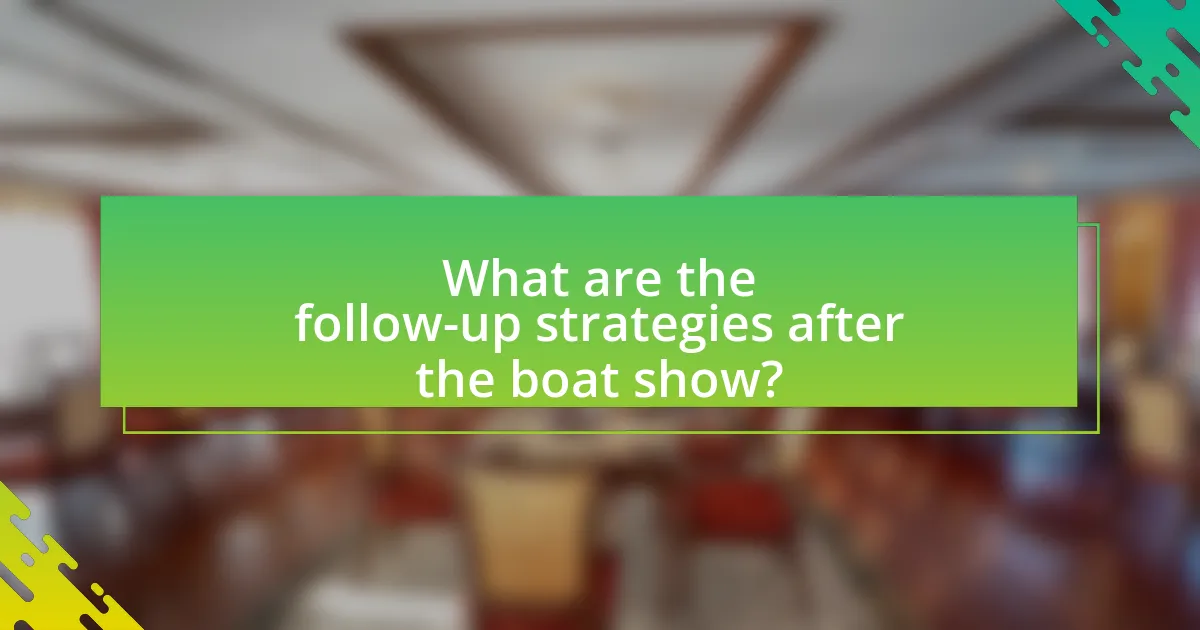
What are the follow-up strategies after the boat show?
Follow-up strategies after the boat show include sending personalized thank-you emails to leads, scheduling follow-up calls to discuss potential sales, and utilizing social media to engage with contacts made during the event. These strategies are effective as they maintain the momentum generated at the show and foster relationships with potential customers. Research indicates that timely follow-ups can increase conversion rates by up to 30%, highlighting the importance of prompt communication in sales processes.
How can exhibitors effectively follow up with leads generated at the show?
Exhibitors can effectively follow up with leads generated at the show by promptly sending personalized emails or messages within 24 to 48 hours after the event. This quick response time increases the likelihood of engagement, as leads are still fresh in their minds. Personalization can include referencing specific conversations or interests expressed during the show, which demonstrates attentiveness and builds rapport. According to a study by the Marketing Institute, timely follow-ups can increase conversion rates by up to 50%. Additionally, utilizing a customer relationship management (CRM) system to track interactions and schedule follow-ups can streamline the process and ensure no lead is overlooked.
What methods are most effective for lead nurturing post-show?
The most effective methods for lead nurturing post-show include personalized follow-up emails, targeted content marketing, and timely phone calls. Personalized follow-up emails can significantly increase engagement, as they address the specific interests of leads gathered during the show. According to a study by the Direct Marketing Association, personalized emails have an open rate of 29% compared to 19% for non-personalized emails. Targeted content marketing, such as sending relevant articles or case studies, helps maintain interest and positions the exhibitor as a knowledgeable resource. Additionally, timely phone calls within a week of the show can enhance connection and demonstrate commitment, with research indicating that leads contacted within five days are 21 times more likely to convert than those contacted later.
How can exhibitors measure the success of their booth participation?
Exhibitors can measure the success of their booth participation through metrics such as lead generation, engagement levels, and return on investment (ROI). Lead generation can be quantified by tracking the number of contacts collected during the event, which provides a direct indication of interest in products or services. Engagement levels can be assessed through interactions at the booth, including the number of demonstrations conducted or promotional materials distributed. ROI can be calculated by comparing the costs of participation, such as booth fees and travel expenses, against the revenue generated from leads converted into sales. According to a study by the Center for Exhibition Industry Research, 76% of attendees are interested in making purchases, highlighting the importance of measuring these metrics to evaluate booth effectiveness.
What are the common pitfalls to avoid after the boat show?
Common pitfalls to avoid after the boat show include neglecting follow-up communication with leads, failing to analyze booth performance, and not updating marketing materials based on feedback. Neglecting follow-up can result in lost sales opportunities, as timely engagement is crucial for converting leads into customers. Failing to analyze booth performance prevents exhibitors from understanding what worked and what didn’t, hindering future improvements. Not updating marketing materials based on feedback can lead to outdated information being presented, which may misalign with current market trends and customer expectations.
How can exhibitors ensure they don’t lose potential sales after the event?
Exhibitors can ensure they don’t lose potential sales after the event by implementing a robust follow-up strategy with leads collected during the event. This involves promptly contacting potential customers through personalized emails or phone calls within a week of the event, as research indicates that timely follow-ups can increase conversion rates by up to 70%. Additionally, utilizing a customer relationship management (CRM) system to track interactions and manage leads can enhance the effectiveness of follow-ups, ensuring that no potential sale is overlooked.
What strategies can be implemented to maintain engagement with prospects?
To maintain engagement with prospects, exhibitors should implement interactive displays and personalized follow-ups. Interactive displays, such as virtual reality experiences or hands-on demonstrations, capture attention and encourage participation, leading to a memorable experience. Personalized follow-ups, including tailored emails or phone calls based on individual interests expressed during the event, reinforce connections and demonstrate attentiveness to prospects’ needs. Research indicates that personalized communication can increase engagement rates by up to 50%, highlighting the effectiveness of these strategies in fostering lasting relationships with potential customers.
What are the top tips for maximizing booth space at future boat shows?
To maximize booth space at future boat shows, exhibitors should focus on strategic layout, engaging displays, and effective signage. A well-planned layout allows for optimal traffic flow, ensuring visitors can easily navigate the space. Engaging displays, such as interactive elements or live demonstrations, attract attention and encourage visitor interaction, increasing the likelihood of conversions. Effective signage, including clear branding and concise messaging, helps communicate key information quickly, guiding potential customers to the booth. Research indicates that booths with interactive elements can increase visitor engagement by up to 50%, highlighting the importance of these strategies in maximizing booth effectiveness.

